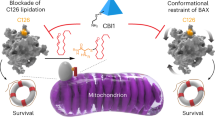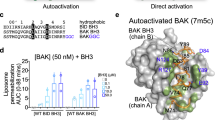Abstract
The Bax protein (Bcl-2-associated X protein) is pivotal for the apoptotic process. Bax, which resides in an inactive form in the cytosol of healthy cells, is activated during the early stages of apoptosis and becomes associated with mitochondria through poorly understood mechanisms. In this study, we show that a family of bioactive lipids, namely prostaglandins, regulates Bax-dependent apoptosis. The prostaglandin E2 (PGE2) or its derivative PGA2 binds to Bax, induces its change of conformation, and thereby triggers apoptosis. A cysteine present in the loop between the two transmembrane α-helices of Bax, Cys126 is critical for its activation. PGD2 inhibits PGE2 binding to Bax and PGE2-induced apoptosis, as well as cell death induced by staurosporine and UV-B in various cell lines. This result is consistent with the fact that apoptosis is accompanied during these treatments by an increase in PGE2. This process is distinct, yet cooperative, from that involving the BH3-only protein Bid. Our results establish that the PGE2/PGD2 balance is involved in a new early mechanism of control in the activation of Bax during apoptosis.
Similar content being viewed by others
Log in or create a free account to read this content
Gain free access to this article, as well as selected content from this journal and more on nature.com
or
Abbreviations
- Bax:
-
Bcl-2-associated X protein
- COX-2:
-
cyclooxygenase 2
- L-PGDS:
-
lipocalin-like prostaglandin D2 synthase
- mPGES-1:
-
microsomal prostaglandin E2 synthase 1
- PGE2:
-
prostaglandin E2
- 15-keto PGE2:
-
15-keto prostaglandin E2
References
Chipuk JE, Bouchier-Hayes L, Green DR . Mitochondrial outer membrane permeabilization during apoptosis: the innocent bystander scenario. Cell Death Differ 2006; 13: 1396–1402.
Green DR . At the gates of death. Cancer Cell 2006; 9: 328–330.
Youle RJ, Strasser A . The BCL-2 protein family: opposing activities that mediate cell death. Nat Rev Mol Cell Biol 2008; 9: 47–59.
Giam M, Huang DC, Bouillet P . BH3-only proteins and their roles in programmed cell death. Oncogene 2008; 27 (Suppl 1): S128–S136.
Cartron PF, Oliver L, Mayat E, Meflah K, Vallette FM . Impact of pH on Bax alpha conformation, oligomerisation and mitochondrial integration. FEBS Lett 2004; 578: 41–46.
Khaled AR, Kim K, Hofmeister R, Muegge K, Durum SK . Withdrawal of IL-7 induces Bax translocation from cytosol to mitochondria through a rise in intracellular pH. Proc Natl Acad Sci USA 1999; 96: 14476–14481.
Pagliari LJ, Kuwana T, Bonzon C, Newmeyer DD, Tu S, Beere HM et al. The multidomain proapoptotic molecules Bax and Bak are directly activated by heat. Proc Natl Acad Sci USA 2005; 102: 17975–17980.
Lalier L, Cartron PF, Pedelaborde F, Olivier C, Loussouarn D, Martin SA et al. Increase in PGE2 biosynthesis induces a Bax dependent apoptosis correlated to patients’ survival in glioblastoma multiforme. Oncogene 2007; 26: 4999–5009.
Huang SK, White ES, Wettlaufer SH, Grifka H, Hogaboam CM, Thannickal VJ et al. Prostaglandin E(2) induces fibroblast apoptosis by modulating multiple survival pathways. Faseb J 2009; 23: 4317–4326.
Sheng H, Shao J, Morrow JD, Beauchamp RD, DuBois RN . Modulation of apoptosis and Bcl-2 expression by prostaglandin E2 in human colon cancer cells. Cancer Res 1998; 58: 362–366.
Tessner TG, Muhale F, Riehl TE, Anant S, Stenson WF . Prostaglandin E2 reduces radiation-induced epithelial apoptosis through a mechanism involving AKT activation and bax translocation. J Clin Invest 2004; 114: 1676–1685.
Tai HH, Ensor CM, Tong M, Zhou H, Yan F . Prostaglandin catabolizing enzymes. Prostaglandins Other Lipid Mediat 2002; 68-69: 483–493.
Bellot G, Cartron PF, Er E, Oliver L, Juin P, Armstrong LC et al. TOM22, a core component of the mitochondria outer membrane protein translocation pore, is a mitochondrial receptor for the proapoptotic protein Bax. Cell Death Differ 2007; 14: 785–794.
Annis MG, Soucie EL, Dlugosz PJ, Cruz-Aguado JA, Penn LZ, Leber B et al. Bax forms multispanning monomers that oligomerize to permeabilize membranes during apoptosis. Embo J 2005; 24: 2096–2103.
Cartron PF, Gallenne T, Bougras G, Gautier F, Manero F, Vusio P et al. The first alpha helix of Bax plays a necessary role in its ligand-induced activation by the BH3-only proteins Bid and PUMA. Mol Cell 2004; 16: 807–818.
Cartron PF, Juin P, Oliver L, Martin S, Meflah K, Vallette FM . Nonredundant role of Bax and Bak in Bid-mediated apoptosis. Mol Cell Biol 2003; 23: 4701–4712.
Suzuki M, Youle RJ, Tjandra N . Structure of Bax: coregulation of dimer formation and intracellular localization. Cell 2000; 103: 645–654.
Gharbi S, Garzon B, Gayarre J, Timms J, Perez-Sala D . Study of protein targets for covalent modification by the antitumoral and anti-inflammatory prostaglandin PGA1: focus on vimentin. J Mass Spectrom 2007; 42: 1474–1484.
Perez-Sala D, Cernuda-Morollon E, Canada FJ . Molecular basis for the direct inhibition of AP-1 DNA binding by 15-deoxy-Delta 12,14-prostaglandin J2. J Biol Chem 2003; 278: 51251–51260.
Gavathiotis E, Suzuki M, Davis ML, Pitter K, Bird GH, Katz SG et al. BAX activation is initiated at a novel interaction site. Nature 2008; 455: 1076–1081.
Kapoor M, Kojima F, Yang L, Crofford LJ . Sequential induction of pro- and anti-inflammatory prostaglandins and peroxisome proliferators-activated receptor-gamma during normal wound healing: a time course study. Prostaglandins Leukot Essent Fatty Acids 2007; 76: 103–112.
Qu WM, Huang ZL, Xu XH, Aritake K, Eguchi N, Nambu F et al. Lipocalin-type prostaglandin D synthase produces prostaglandin D2 involved in regulation of physiological sleep. Proc Natl Acad Sci USA 2006; 103: 17949–17954.
Telleria-Diaz A, Ebersberger A, Vasquez E, Schache F, Kahlenbach J, Schaible HG . Different effects of spinally applied prostaglandin D2 on responses of dorsal horn neurons with knee input in normal rats and in rats with acute knee inflammation. Neuroscience 2008; 156: 184–192.
Wang K, Yin XM, Chao DT, Milliman CL, Korsmeyer SJ . BID: a novel BH3 domain-only death agonist. Genes Dev 1996; 10: 2859–2869.
Moreau C, Cartron PF, Hunt A, Meflah K, Green DR, Evan G et al. Minimal BH3 peptides promote cell death by antagonizing anti-apoptotic proteins. J Biol Chem 2003; 278: 19426–19435.
Wang D, Dubois RN . Eicosanoids and cancer. Nat Rev Cancer 2010; 10: 181–193.
Pica F, Franzese O, D′Onofrio C, Bonmassar E, Favalli C, Garaci E . Prostaglandin E2 induces apoptosis in resting immature and mature human lymphocytes: a c-Myc-dependent and Bcl-2-independent associated pathway. J Pharmacol Exp Ther 1996; 277: 1793–1800.
Chen C, Bazan NG . Lipid signaling: sleep, synaptic plasticity, and neuroprotection. Prostaglandins Other Lipid Mediat 2005; 77: 65–76.
Smyth EM, Grosser T, Wang M, Yu Y, FitzGerald GA . Prostanoids in health and disease. J Lipid Res 2009; 50 (Suppl): S423–S428.
Ikeda-Matsuo Y, Ota A, Fukada T, Uematsu S, Akira S, Sasaki Y . Microsomal prostaglandin E synthase-1 is a critical factor of stroke-reperfusion injury. Proc Natl Acad Sci USA 2006; 103: 11790–11795.
Samuelsson B, Morgenstern R, Jakobsson PJ . Membrane prostaglandin E synthase-1: a novel therapeutic target. Pharmacol Rev 2007; 59: 207–224.
Polyak K, Xia Y, Zweier JL, Kinzler KW, Vogelstein B . A model for p53-induced apoptosis. Nature 1997; 389: 300–305.
Mattila S, Tuominen H, Koivukangas J, Stenback F . The terminal prostaglandin synthases mPGES-1, mPGES-2, and cPGES are all overexpressed in human gliomas. Neuropathology 2009; 29: 156–165.
Payner T, Leaver HA, Knapp B, Whittle IR, Trifan OC, Miller S et al. Microsomal prostaglandin E synthase-1 regulates human glioma cell growth via prostaglandin E(2)-dependent activation of type II protein kinase A. Mol Cancer Ther 2006; 5: 1817–1826.
Payne CA, Maleki S, Messina M, O’Sullivan MG, Stone G, Hall NR et al. Loss of prostaglandin D2 synthase: a key molecular event in the transition of a low-grade astrocytoma to an anaplastic astrocytoma. Mol Cancer Ther 2008; 7: 3420–3428.
Zhu F, Wang P, Kontrogianni-Konstantopoulos A, Konstantopoulos K . Prostaglandin (PG)D(2) and 15-deoxy-Delta(12,14)-PGJ(2), but not PGE(2), mediate shear-induced chondrocyte apoptosis via protein kinase A-dependent regulation of polo-like kinases. Cell Death Differ 17: 1325–1334.
Kokoglu E, Tuter Y, Sandikci KS, Yazici Z, Ulakoglu EZ, Sonmez H et al. Prostaglandin E2 levels in human brain tumor tissues and arachidonic acid levels in the plasma membrane of human brain tumors. Cancer Lett 1998; 132: 17–21.
Jones G, Willett P, Glen RC, Leach AR, Taylor R . Development and validation of a genetic algorithm for flexible docking. J Mol Biol 1997; 267: 727–748.
Wang R, Lai L, Wang S . Further development and validation of empirical scoring functions for structure-based binding affinity prediction. J Comput Aided Mol Des 2002; 16: 11–26.
Acknowledgements
This work was supported by a special grant from the Ligue contre le Cancer (Equipe labellisée Ligue). We thank Dr. J Grassi (CEA/Saclay, France) for the gift of AChE-coupled PGE2 and recombinant AChE and Gaëlle Blanchet (Service de Biochimie, Faculté de Medecine de Nantes, France) for technical assistance.
Author information
Authors and Affiliations
Corresponding author
Ethics declarations
Competing interests
The authors declare no conflict of interest.
Additional information
Edited by B Zhivotovsky
Author contributions
Lisenn Lalier performed the in vitro experiments and drafted the manuscript. Pierre Francois Cartron performed the acellular studies, Christophe Olivier performed some of the microinjection experiments, Gwenola Bougras carried out the phenotyping characterization of the cell lines and Lisa Oliver the immunohistochemical characterization and confocal studies. Cedric Logé and Jean-Michel Robert participated in the molecular modeling of PGE2/Bax interaction. Francois M Vallette conceived of the study and wrote the final version of the manuscript.
Supplementary Information accompanies the paper on Cell Death and Differentiation website
Supplementary information
Rights and permissions
About this article
Cite this article
Lalier, L., Cartron, PF., Olivier, C. et al. Prostaglandins antagonistically control Bax activation during apoptosis. Cell Death Differ 18, 528–537 (2011). https://doi.org/10.1038/cdd.2010.128
Received:
Revised:
Accepted:
Published:
Issue date:
DOI: https://doi.org/10.1038/cdd.2010.128
Keywords
This article is cited by
-
15d-Prostaglandin J2 induced reactive oxygen species-mediated apoptosis during experimental visceral leishmaniasis
Journal of Molecular Medicine (2016)
-
Intracellular EP2 prostanoid receptor promotes cancer-related phenotypes in PC3 cells
Cellular and Molecular Life Sciences (2015)
-
Transactivation of EGFR by prostaglandin E2 receptors: a nuclear story?
Cellular and Molecular Life Sciences (2015)
-
Bioactive lipids and the control of Bax pro-apoptotic activity
Cell Death & Disease (2014)
-
Metabolic effects of TiO2 nanoparticles, a common component of sunscreens and cosmetics, on human keratinocytes
Cell Death & Disease (2013)



